Several stages of caries development
How does the initial stage of caries manifest?
The first stage is the initial stage of caries - when a chalky stain appears on the tooth, such a concept used to be present. At this point, the tooth enamel loses its transparency and becomes completely white. Hence the name - as if drawn with chalk. This carious spot may become pigmented or darken. In this case, it is believed that caries has stopped in the enamel and the destruction process no longer proceeds. This is a controversial theory, since only a dentist can assess the condition of a tooth.
What are caries spots? According to the modern classification, these are enamel caries and dentin caries.
Previously, there was such a classification: spot stage, superficial, medium and deep caries. But regardless of classification, any caries is worth treating.
The second stage of caries after the stain is enamel caries
When the carious process occurs only in the tooth enamel, this is superficial caries.
The third stage of caries - a dark spot on the tooth
If a patient comes and says that I react to sweets, he will have the most favorable treatment outcome
The third stage or middle caries looks like a dark spot on the tooth. In this place, the enamel has already been destroyed, and the disease goes deep into the tooth. This occurs when dentin caries appears.
How is caries on the front teeth treated?
If you have caries on your front teeth, you need to start treatment as soon as possible. Therapeutic methods directly depend on the location of the disease and stage. In addition, the treatment of caries on the front teeth is complicated by various factors.
Relatively new methods for treating caries on the front teeth
- Filling. The most common therapeutic technique. Due to increased aesthetic requirements (especially if caries has occurred on the front surface of the tooth), light (photopolymer) fillings are used. Treatment of caries between the front teeth requires special precision: it is necessary not only to choose the correct color of the material, but also to recreate the natural shape of the teeth and the interdental space.
- Orthopedic treatment. If the damage is severe, it is often impossible to install a filling. In this case, veneers and crowns come to the rescue, allowing you to restore the aesthetics and functionality of the tooth. In particularly severe situations, removal is required. For example, classical treatment of root caries of the front teeth at the last stage is often not possible, so the most effective solution is implantation.
- Infiltration method. We are talking primarily about Icon technology, however, removal of caries on the front teeth is possible only at the initial stage.
Prices for treatment of caries of anterior teeth in Moscow
The price for treating caries of anterior teeth largely depends on the technique used. Standard therapy with the installation of a light filling will cost from 5,800 rubles. But prices for restoration start at 12,500 rubles. Treatment costs approximately the same without an Icon drill. Treatment of pulpitis on the front teeth involves cleaning the canals, which will add several thousand more to the total amount. If the tooth is seriously damaged and installing a filling is impossible, get ready for serious expenses. The average cost of a ceramic crown is from 25,000–30,000 rubles, and turnkey implantation will cost at least 55,000–100,000 rubles for the installation of one implant.
Preparing for treatment
Elimination of the defect requires a comprehensive examination of the oral cavity and selection of optimal treatment. In particular, the doctor assesses the size of the pathological holes. An x-ray examination is also prescribed, which allows you to identify the presence of hidden injuries. Regardless of the chosen scheme, before starting treatment of rare teeth, therapy for caries and other pathologies of the oral cavity is prescribed.
Self-medication is dangerous with complications!
Attention
Despite the fact that our articles are based on trusted sources and have been tested by practicing doctors, the same symptoms can be signs of different diseases, and the disease may not proceed according to the textbook.
Pros of seeing a doctor:
- Only a specialist will prescribe suitable medications.
- Recovery will be easier and faster.
- The doctor will monitor the course of the disease and help avoid complications.
find a doctor
Do not try to treat yourself - consult a specialist.
The most difficult operation to correct a malocclusion is implantation. Before it is performed, a panoramic photograph of the jaw is taken, which allows you to select the appropriate pin size.
Implantation is contraindicated in many cases. It cannot be used in the presence of oncological pathologies, tuberculosis, a number of chronic diseases and allergies to anesthesia. Implantation takes several hours. During the procedure, tooth extension is carried out in three projections: width, height and length.
After the operation, the patient should follow certain procedures for several months to prevent the development of complications.
Types of edentia
Missing teeth and deficient bone volume are often associated with advanced age or traumatic injury. But practice shows that there are several types of such violations.
Primary adentia
A rare pathology associated with improper development of the jaws in a baby. It is detected at the time of eruption of milk teeth or when they are replaced by permanent ones. When there are no rudiments of future teeth in the jaw, the anomaly is called true. In case of developmental delay, late appearance of units (often the crowns overlap each other, merging into a single mass) – false. According to statistics, a birth defect is the frequent absence of crowns from the second to the third chewing molar.
Secondary adentia
This type is acquired, a consequence of severe forms of periodontal tissue diseases, injuries, and somatic ailments. Indeed, a common occurrence in older people. One of the accompanying factors in the development of adentia in this category is the lack of effective and gentle methods of dental care and prosthetics in past decades. The most common types are partial edentia (several units missing) and complete edentia (no teeth at all).
Causes of the anomaly
The reasons for “short” teeth can be many factors, both actually reducing the size of clinical crowns and creating a visual effect of their reduction:
- Heredity. “Short” teeth of parents are often genetically passed on to their children.
- Increased abrasion of occlusal surfaces , as a result of which clinical crowns become shorter. The reasons for increased abrasion can be different; this is a large independent topic.
- Inflammatory processes in the periodontium , directly or indirectly affecting the size of the clinical crown.
- Metabolic disorders in periodontal and dental tissues , including those caused by malnutrition of hard and soft tissues.
- Excessive thinness of the upper lip , in which the gums are exposed more than they should when smiling.
- Increased size of the lip frenulum , which “creeps” onto the crown.
- Gingival hyperplasia , leading to the closure of part of the crown.
- Underdevelopment of the alveolar process , leading to a lack of sufficient support for normal tooth growth.
- Radiation exposure.
- Early removal of milk jugs.
However, the most significant and common causes are still considered to be disturbances in the formation of teeth in the embryonic and childhood periods - both genetic and reactive (acquired) in nature.
For example, severe infections suffered in infancy or serious illnesses of the mother during pregnancy.
Possible consequences
The main problem of microdentia with preserved functionality of the dentofacial apparatus is the psychological discomfort that the patient experiences when realizing his defect. This is not as harmless as it might seem at first glance.
A person’s psychological state can have a decisive impact on his quality of life, cause central nervous system disorders and even lead to physical illness.
If microdentia is accompanied by functional and organic disorders, somatic diseases are added to psychological problems. This may be a gastrointestinal disease due to poor chewing of food, asymmetry disorder and the effect of premature aging of the face when the lower third is reduced due to a low bite, etc.
Ultimately, the consequence of “short” teeth can be a general deterioration in health caused by both physical and psychological factors.
As for the influence of microdentia on the condition of the dentofacial apparatus, it can be expressed in the following:
- Displacement of the crowns distally , that is, backwards.
- Formation of tremata and diastemas , as a result of which the teeth lose stability in the mesial-distal direction and create an increased load when chewing on the periodontal ligament. It should be noted that normally all crowns have contact with each other in the proximal areas.
- Impaired diction due to the gap between the teeth and the low height of the clinical crown.
- Development of periodontitis and periodontal disease.
Summarizing all of the above, it is necessary to conclude that severe microdentia must be corrected.
How difficult and dangerous is it to remove an impacted tooth in modern dentistry?
In this publication, we will consider the features of treatment of dental anomalies - hyperdontia.
Here https://orto-info.ru/zubocheliustnye-anomalii/zubov/kolichestva/gipodentiya.html all the most important things about hypodentia.
How much does a perfect smile without gaps between teeth cost?
A perfect smile without gaps requires, first of all, a lot of patience and a little trust. Material costs depend on your choice and on the country where you want to be treated. Non-EU countries widely practice dental tourism, offering very competitive prices.
Braces, for example, in our clinic are not at all expensive (from 550 euros to 750 euros), you need to come to Moldova for adjustments. This is why we recommend that you evaluate how rational or economical the entire treatment will be.
Ceramic veneers cost 225 euros per tooth. Their advantage is that the treatment is carried out in one stage, which makes it very attractive to people abroad. To prepare teeth for EMAX ceramic veneers, we use a microscope and other magnifying devices, which makes the preparation (grinding) imperceptible, but the end result will surprise you to tears.











